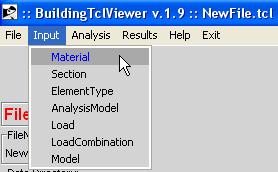|
|
| (58 intermediate revisions by the same user not shown) |
| Line 1: |
Line 1: |
| <noinclude>__NOTOC__ | | <noinclude> |
| [[Image:BuildingTclLogo.gif|link=BuildingTcl|right]] | | [[Image:BuildingTclLogo.gif|link=BuildingTcl|right]] |
|
| |
|
| == Input Management -- create or edit ==
| | The input menu allows the user to creat new BuildingTcl objects or to modify existing ones. |
| </noinclude>
| | |
| | |
| [[Image:BuildingTclViewerInputMenu.JPG|link=BuildingTclViewer Input Menu]] | | [[Image:BuildingTclViewerInputMenu.JPG|link=BuildingTclViewer Input Menu]] |
|
| |
|
| The user can either create new or edit a library of the following BuildingTcl objects: | | The user can either create new or edit a library of the following BuildingTcl objects: |
| * Material | | *[[BuildingTclViewer Input Menu -- Common Characteristics |Common Characteristics ]] |
| * Section | | *[[BuildingTclViewer Input Menu -- Material |Material ]] |
| * ElementType | | *[[BuildingTclViewer Input Menu -- Section |Section ]] |
| * AnalysisModel | | *[[BuildingTclViewer Input Menu -- ElementType |ElementType ]] |
| * Load | | *[[BuildingTclViewer Input Menu -- AnalysisModel |AnalysisModel ]] |
| * LoadCombination | | *[[BuildingTclViewer Input Menu -- Load |Load ]] |
| * Model | | *[[BuildingTclViewer Input Menu -- LoadCombination|LoadCombination]] |
| | * Model -- There are three ModelTypes available in BuildingTcl: |
| | **[[BuildingTclViewer Input Menu -- Elevation Model|Elevation Model]] |
| | **[[BuildingTclViewer Input Menu -- Plan Model|Plan Model]] |
| | **[[BuildingTclViewer Input Menu -- 3DFrame Model|3DFrame Model]] |
|
| |
|
| These BuildingTcl objects have been presented in the [[BuildingTcl Command Language Manual]] | | These input arguments for these BuildingTcl objects have been presented in the [[BuildingTcl Command Language Manual]] |
|
| |
|
| <noinclude> | | <noinclude> |
|
| |
| == Common Characteristics ==
| |
| All of these input option begin with the selection of creating a new object, or edit an existing one. The case for material is shown here.
| |
|
| |
| [[Image:BuildingTclViewerInputNewEdit.JPG|link=BuildingTclViewer Input Menu]]
| |
|
| |
| === New ===
| |
| When a new object is to be created, the user must first select the BuildingTcl model used for such object.
| |
|
| |
| [[Image:BuildingTclViewerInputSelectModel.JPG|link=BuildingTclViewer Input Menu]]
| |
|
| |
| The input arguments are dependent on the model selected. However, they are grouped in the following:
| |
| ;Unique Object label : The user specifies this label
| |
| :The default value is the model label. If this label has already been used, the program adds an underscore and an identifying number after this label.
| |
| ;Save : Save the newly-defined object into the library.
| |
|
| |
| === Edit ===
| |
| The user must first select a previously-defined BuildingTcl object.
| |
|
| |
| [[Image:BuildingTclViewerInputEditMaterial.JPG|link=BuildingTclViewer Input Menu]]
| |
|
| |
| The input arguments are dependent on the model used for the object. The user can change the model, however, all input will be lost and default values are restored.
| |
| ;Modify/Save : The new values for the object replace the previously-defined ones, which cannot be restored.
| |
| ;Save As... : A new object with a new label will be saved into the library without affecting the original object.
| |
| : The user can specify a new name for this object. The default will be the name of the original object, with an underscore and a count number after it.
| |
|
| |
|
| |
| === New & Edit ===
| |
| ;Required Arguments : These arguments must be specified by the user.
| |
| ;Optional Arguments : These arguments can be specified by the user. The initial value of these arguments is the default value
| |
|
| |
| == Material ==
| |
| The following items are found in the Input Menu for a Material:
| |
| *Material Label
| |
| *Material Model Label
| |
| *Input Arguments
| |
| **Required Arguments
| |
| **Optional Arguments
| |
| *Material Test:
| |
| **Test Button -- perform test. A graphic of the stress-strain response is shown after the OpenSees analysis on the material has been done. The material arguments are posted next to this graph.
| |
| **Test-Load Type -- different types of monotonic or cyclic loading patterns can be selected
| |
| **Number of Test Cycles -- the user can select the number of cycles performed at each peak in the load pattern
| |
| **RealTime Option -- when the user checks this option, the analysis data is diplayed real-time. This feature enables a better appreciation of the loading pattern, but slows down the analysis significantly. The real-time display window is closed automatically by the program once the analysis has terminated, so it may be visible for a very short time. The user can stop the analysis at any time using the Stop button in the real-time display window.
| |
| **Material Strain Range -- Maximum strain for test load
| |
| **range of MaterialStrainRange -- change the scale of the range for the MaterialStrainRange
| |
|
| |
| [[Image:BuildingTclViewerInputMaterial.JPG|link=BuildingTclViewer Input Menu]]
| |
|
| |
| == Section ==
| |
|
| |
| == ElementType ==
| |
|
| |
| == AnalysisModel ==
| |
|
| |
| == Load ==
| |
|
| |
| == LoadCombination ==
| |
|
| |
| == Model ==
| |
|
| |
|
| |
|
| |
| ---- | | ---- |
| [[BuildingTclViewer User Manual|Return to BuildingTclViewer User Manual]] | | [[BuildingTclViewer User Manual|Return to BuildingTclViewer User Manual]] |
| </noinclude> | | </noinclude> |

